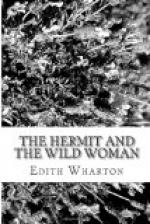In the end she decided not to send the letter. He had never spoken to her of his engagement to Gwendolen Matcher, and his letters had contained no allusion to any sentimental disturbance in his life. She had only his few broken words, that night by the river, on which to build her theory of the case. But illuminated by the phrase “an unfortunate attachment” the theory towered up, distinct and immovable, like some high landmark by which travellers shape their course. She had been loved—extraordinarily loved. But he had chosen that she should know of it by his silence rather than by his speech. He had understood that only on those terms could their transcendant communion continue—that he must lose her to keep her. To break that silence would be like spilling a cup of water in a waste of sand. There would be nothing left for her thirst.
Her life, thenceforward, was bathed in a tranquil beauty. The days flowed by like a river beneath the moon—each ripple caught the brightness and passed it on. She began to take a renewed interest in her familiar round of duties. The tasks which had once seemed colourless and irksome had now a kind of sacrificial sweetness, a symbolic meaning into which she alone was initiated. She had been restless—had longed to travel; now she felt that she should never again care to leave Wentworth. But if her desire to wander had ceased, she travelled in spirit, performing invisible pilgrimages in the footsteps of her friend. She regretted that her one short visit to England had taken her so little out of London—that her acquaintance with the landscape had been formed chiefly through the windows of a railway carriage. She threw herself into the architectural studies of the Higher Thought Club, and distinguished herself, at the spring meetings, by her fluency, her competence, her inexhaustible curiosity on the subject of the growth of English Gothic. She ransacked the shelves of the college library, she borrowed photographs of the cathedrals, she pored over the folio pages of “The Seats of Noblemen and Gentlemen.” She was like some banished princess who learns that she has inherited a domain in her own country, who knows that she will never see it, yet feels, wherever she walks, its soil beneath her feet.
May was half over, and the Higher Thought Club was to hold its last meeting, previous to the college festivities which, in early June, agreeably disorganized the social routine of Wentworth. The meeting was to take place in Margaret Ransom’s drawing-room, and on the day before she sat upstairs preparing for her dual duties as hostess and orator—for she had been invited to read the final paper of the course. In order to sum up with precision her conclusions on the subject of English Gothic she had been rereading an analysis of the structural features of the principal English cathedrals; and she was murmuring over to herself the phrase: “The longitudinal arches of Lincoln have an approximately elliptical form,” when there came a knock on the door, and Maria’s voice announced: “There’s a lady down in the parlour.”




